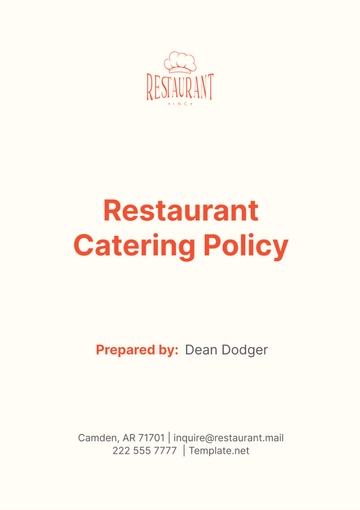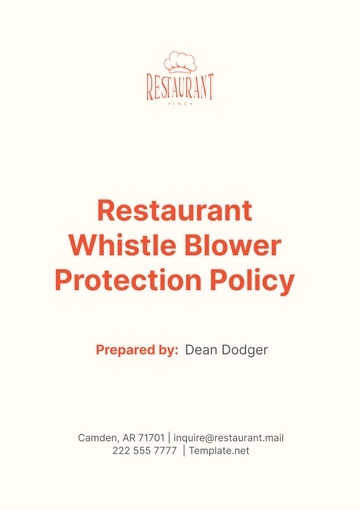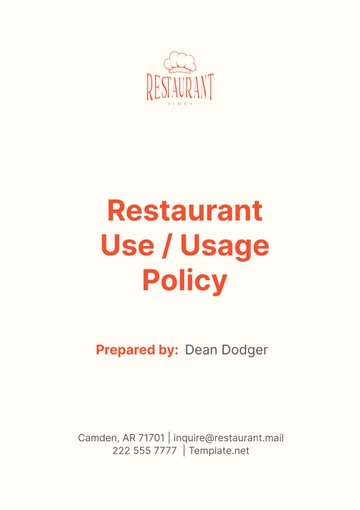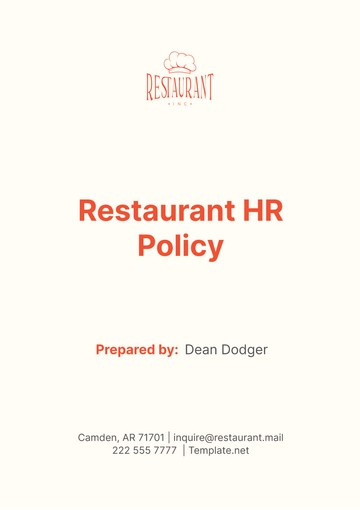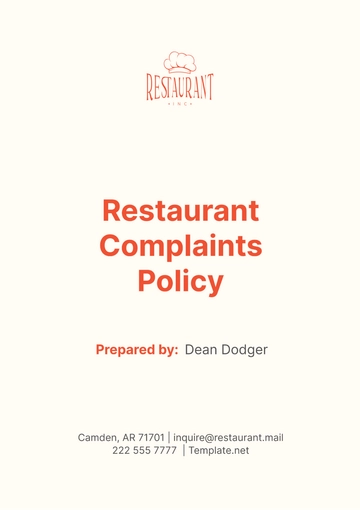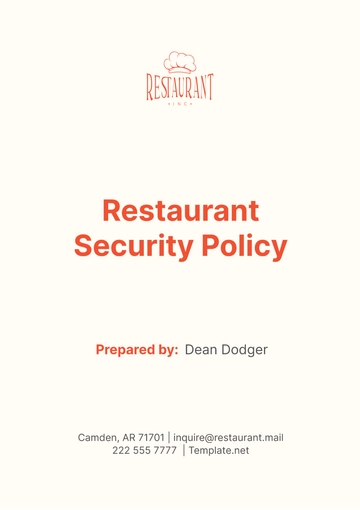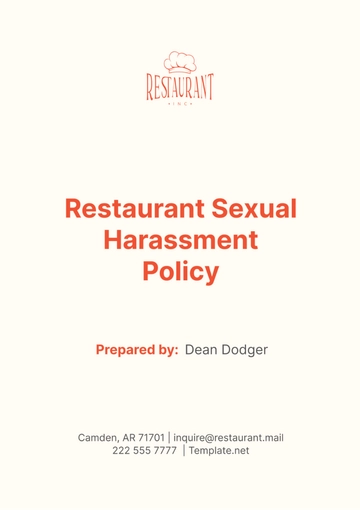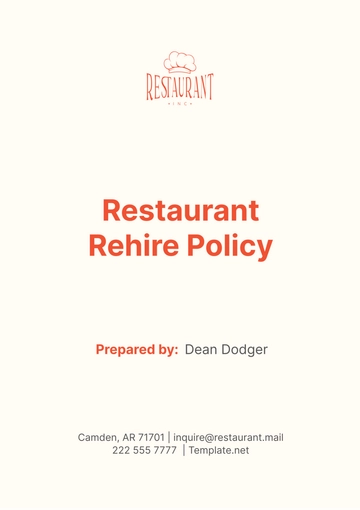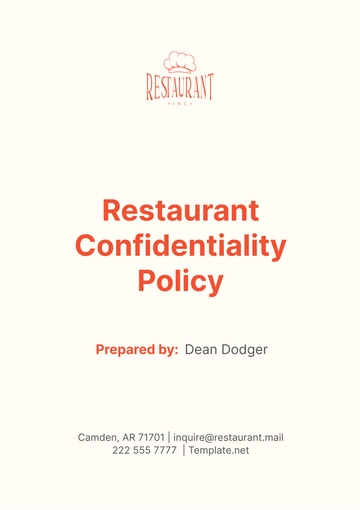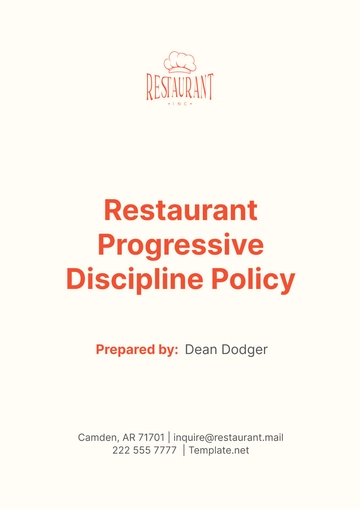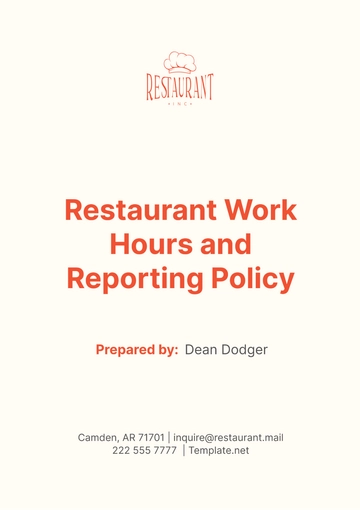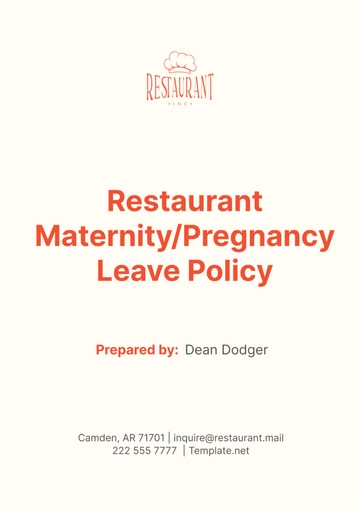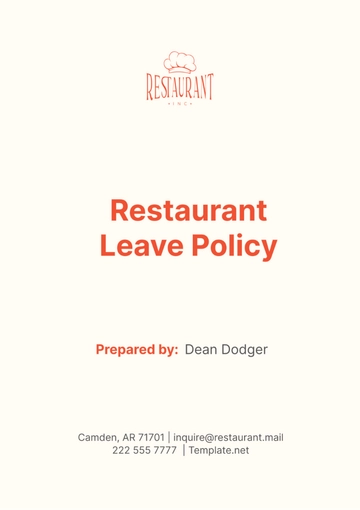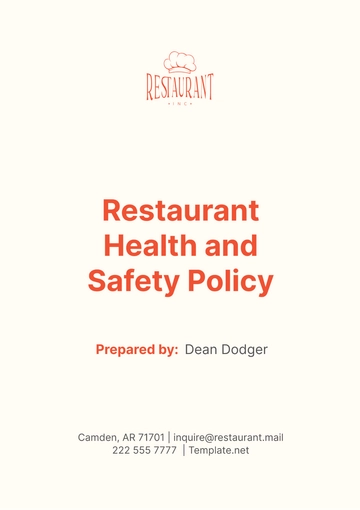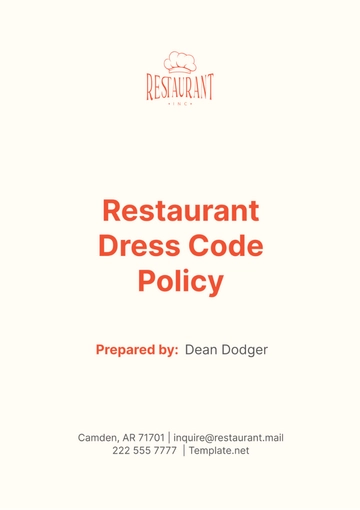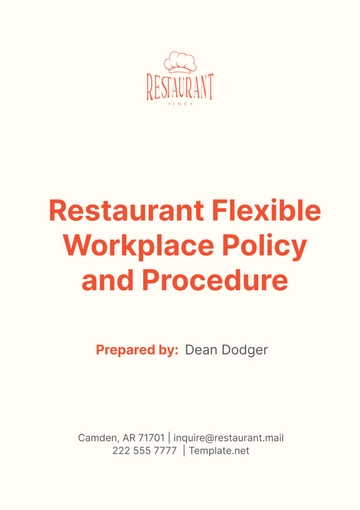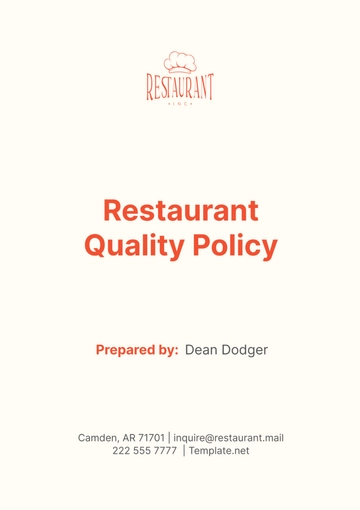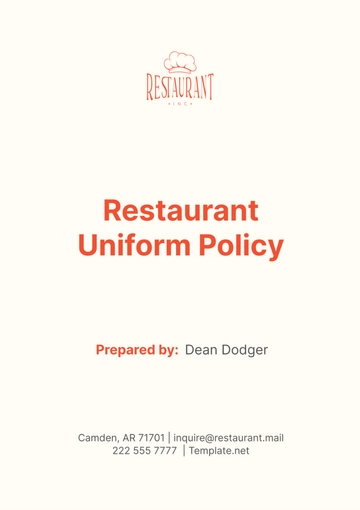Free Restaurant Security Policy
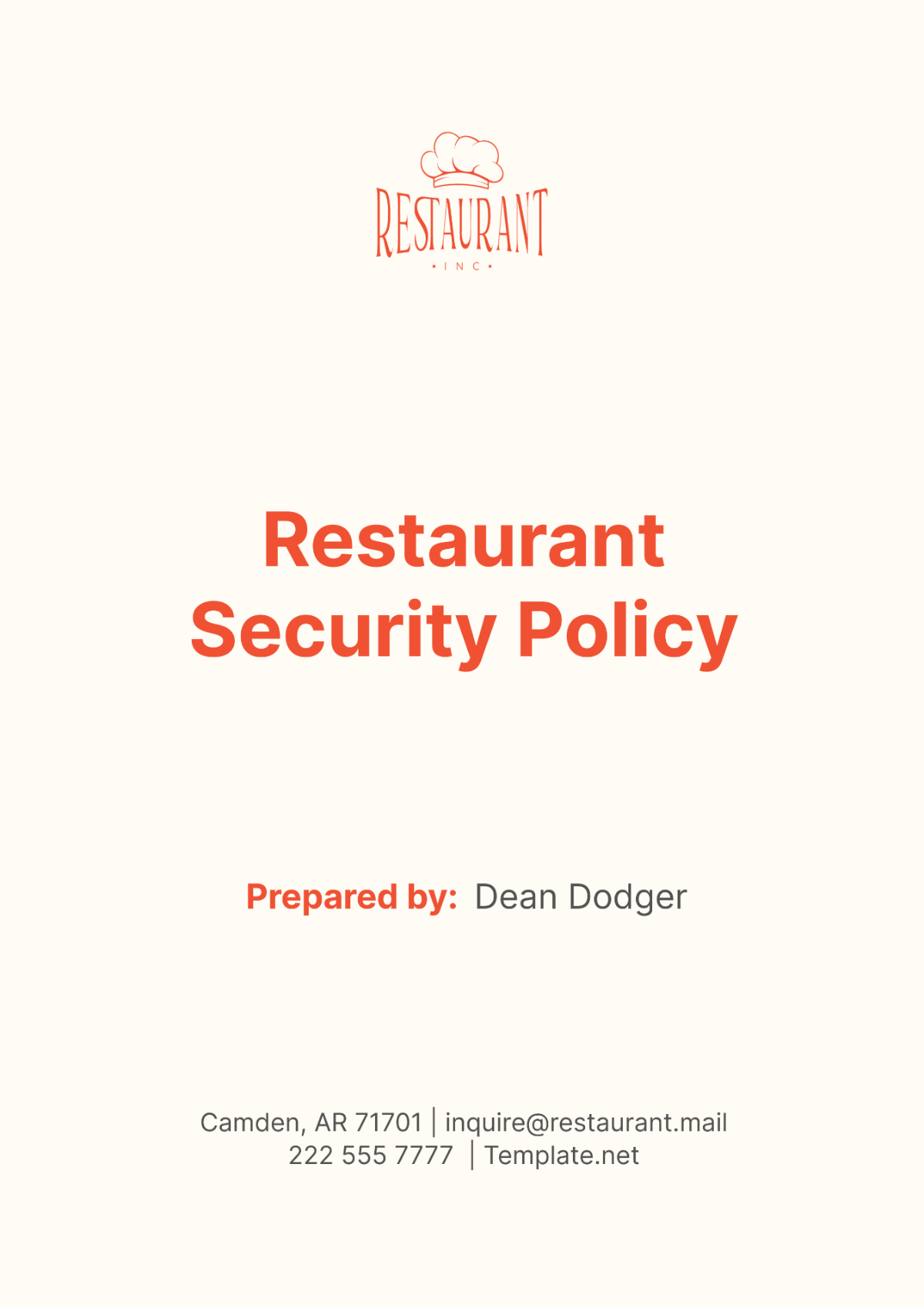
I. Introduction
A. Purpose
The purpose of this Restaurant Security Policy at [Your Company Name] is to ensure a safe and secure environment for our customers, employees, and assets. This policy aims to minimize risks, prevent security breaches, and handle incidents efficiently and effectively. It serves as our commitment to maintaining a secure environment where everyone can feel safe and enjoy their dining experience.
B. Scope
This policy applies to all employees, contractors, vendors, and visitors of [Your Company Name]. It encompasses all physical and digital assets within our restaurant facilities. This broad scope ensures that every aspect of our operations is covered by our security measures, providing comprehensive protection for our business and everyone involved.
C. Importance of Security
Security is a fundamental aspect of our operations at [Your Company Name]. It not only protects our assets but also contributes to the overall customer experience. By ensuring a secure environment, we can provide a comfortable and enjoyable dining experience for our customers.
D. Compliance with Laws and Regulations
We are committed to complying with all relevant laws and regulations related to security. This includes local and national laws, as well as industry-specific regulations. Compliance is not just about avoiding penalties - it’s about demonstrating our commitment to security and earning the trust of our customers.
II. Security Roles and Responsibilities
The following table outlines the roles and responsibilities pertaining to security within our restaurant:
Role | Responsibility |
|---|---|
General Manager | Oversees the overall implementation of the security policy. |
Security Manager | Manages daily security operations and incident responses. |
Employees | Report suspicious activities and adhere to security protocols. |
IT Administrator | Ensures cybersecurity measures are in place and maintained. |
A. Role of the General Manager
The General Manager plays a crucial role in our security operations. They oversee the overall implementation of the security policy, ensuring that all aspects of our operations align with our security objectives. The General Manager also plays a key role in promoting a culture of security within our organization.
B. Role of the Security Manager
The Security Manager is responsible for managing daily security operations and incident responses. They coordinate security measures, respond to incidents, and ensure that our security protocols are followed. The Security Manager is our first line of defense against security threats.
C. Role of Employees
Our employees play a vital role in maintaining security. They are responsible for reporting suspicious activities and adhering to our security protocols. By staying vigilant and following our guidelines, our employees help create a secure environment for everyone.
D. Role of the IT Administrator
The IT Administrator ensures that cybersecurity measures are in place and maintained. They manage our digital infrastructure, implement security measures, and respond to cyber threats. The IT Administrator plays a crucial role in protecting our digital assets and maintaining the integrity of our IT systems.
Each role plays a crucial part in maintaining our security. From the General Manager to our employees, everyone has a part to play in creating a secure environment. By understanding and fulfilling their responsibilities, each individual contributes to our overall security and helps protect our restaurant.
III. Physical Security
A. Surveillance Systems
At [Your Company Name], we have implemented 24/7 surveillance cameras that cover all entry and exit points of our restaurant. These cameras are a critical part of our security infrastructure, providing real-time monitoring of our premises. They help us detect any unusual activities and respond promptly, ensuring the safety of our customers and staff.
B. Access Control Systems
Our restaurant is equipped with advanced access control systems that use keycard entry for authorized personnel only. This system is designed to prevent unauthorized access to sensitive areas within our premises. It helps us maintain control over who can enter specific areas, thereby enhancing the overall security of our restaurant.
C. Regular Security Patrols
To further enhance our physical security, we conduct regular security patrols during both operating and non-operating hours. These patrols serve as an additional layer of security, allowing us to proactively identify and address potential security issues. They also act as a deterrent, discouraging potential intruders.
D. Emergency Alarm Systems
Our emergency alarm systems are connected to local law enforcement and fire departments. In the event of an emergency, these systems allow us to quickly alert the relevant authorities, ensuring a rapid response to mitigate any potential harm or damage.
IV. Digital Security
A. Secure Wi-Fi Networks
In today’s digital age, securing our digital infrastructure is as important as securing our physical assets. We provide secure Wi-Fi networks with encryption standards for our staff and customers. This helps protect data transmitted over our networks and prevents unauthorized access.
B. Regular Updates and Patches
We ensure regular updates and patches to all digital systems and software. This helps us protect against known vulnerabilities and keep our systems secure against evolving cyber threats. Regular updates and patches are a critical part of our digital security strategy.
C. Firewall and Antivirus Protection
All our devices and servers are equipped with firewall and antivirus protection. These security measures help detect and block malicious activities, protecting our systems from malware and other cyber threats. They form a crucial line of defense in our digital security infrastructure.
D. Strong Password Policies
We enforce strong password policies and multi-factor authentication for system access. These measures add an extra layer of security, making it more difficult for unauthorized individuals to gain access to our systems. They are an essential part of our efforts to protect sensitive data and maintain the integrity of our digital infrastructure.
V. Incident Response
In the event of a security incident, it’s crucial to have a well-defined process in place. The following table outlines our incident response process:
No. | Step |
|---|---|
1 | Detection |
2 | Reporting |
3 | Analysis |
4 | Containment |
5 | Eradication |
6 | Recovery |
7 | Review |
A. Detection
The first step in our incident response process is detection. This involves identifying possible security incidents through surveillance or reports. Our staff is trained to recognize potential security threats and report them immediately.
B. Reporting
Once a potential security incident has been detected, it is reported to the Security Manager immediately. This ensures that the appropriate personnel are aware of the situation and can begin responding accordingly.
C. Analysis
After a security incident has been reported, we conduct a thorough investigation to understand its scope and impact. This analysis helps us determine the severity of the incident and guides our response strategy.
D. Containment
Once we’ve analyzed the incident, we take immediate action to contain it and prevent further damage. This could involve isolating affected systems, blocking malicious IP addresses, or other measures depending on the nature of the incident.
E. Eradication
After containing the incident, we work to remove the cause of the incident. This could involve removing malware from our systems, closing security loopholes, or other actions to ensure the incident does not recur.
F. Recovery
Once the incident has been eradicated, we focus on recovery. This involves restoring and validating system functionality and business operations. We work to minimize downtime and disruption to our services.
G. Review
Finally, we conduct a review of the incident and our response. This involves analyzing what happened, how we responded, and what we can do to prevent similar incidents in the future. This review process is crucial for continuous improvement and learning.
Having a well-defined incident response process is crucial for managing security incidents effectively. It ensures that we can respond quickly and effectively to mitigate any potential harm or damage. Furthermore, it demonstrates our commitment to maintaining a secure environment for our customers and staff.
VI. Training and Awareness
A. Employee Training
All employees, without exception, will receive regular and comprehensive training on our security protocols. This includes, but is not limited to, understanding the importance of security measures, recognizing potential threats, and learning how to respond effectively to security incidents.
B. Incident Response Procedures
Alongside general security training, specific procedures for responding to security incidents will be taught. This ensures that all staff members are prepared to act swiftly and appropriately in the event of a security breach.
C. Security Awareness Programs
To reinforce the training and ensure continuous understanding and compliance with this policy, regular security awareness programs will be conducted. These programs will serve as a platform for discussing new threats, sharing best practices, and reinforcing the importance of security in our daily operations.
VII. Policy Review
A. Annual Review
This Security Policy will be reviewed at least annually. The purpose of this review is to ensure that the policy remains effective and relevant, considering the evolving nature of security threats and the restaurant industry.
B. Policy Updates
Following the review, the policy will be updated as necessary to reflect changes in security best practices, operational needs, or regulatory requirements. This ensures that our policy remains aligned with the current security landscape.
C. Change Communication
Any changes made to the policy will be communicated promptly to all staff members. This ensures that everyone is aware of their responsibilities and the expectations placed upon them by the updated policy.
D. Continuous Improvement
We are committed to a culture of continuous improvement. Feedback from staff members regarding the effectiveness of the security measures in place is encouraged and will be considered during the policy review process. This allows us to adapt our policy based on practical, on-the-ground experience.
- 100% Customizable, free editor
- Access 1 Million+ Templates, photo’s & graphics
- Download or share as a template
- Click and replace photos, graphics, text, backgrounds
- Resize, crop, AI write & more
- Access advanced editor
Enhance your restaurant's security measures using the Restaurant Security Policy Template available on Template.net! This editable template is fully customizable to suit your specific security needs. The AI Editor Tool assists in drafting a professional policy that ensures the safety of both your employees and customers, covering all critical aspects!
You may also like
- HR Policy
- Restaurant Policy
- Company Policy
- Accounting Policies and Procedures
- Website Policy
- Privacy Policy
- Safety Policy
- School Policy
- IT and Software Policy
- Law Firm Policy
- Construction Policy
- Interior Design Policy
- Travel Agency Policy
- Education Academic Policy
- Security Policy
- Real Estate Policy
- Expense Policy
- Software Policy



